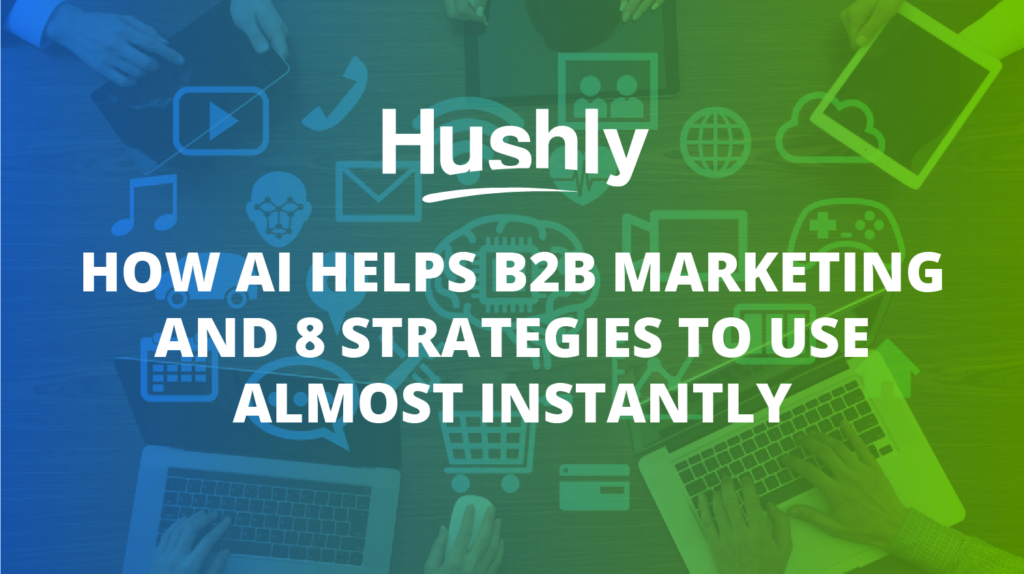Filters
Content Type
Topic
Spending Money on Unused B2B Martech? You’re Not Alone

I’m sure I’m about to describe a familiar situation for many B2B Martech Customer Success Managers.
A new client invests their money into your technology, but they never even use it – and if they do, they don’t use all the key features.
As the leader of the Hushly Success Team, I face a consistent challenge: The burden of trying to help customers take full advantage of everything our AI engine and martech platform have to offer.
I’ve been in the business of selling or marketing to other marketers for the past 20-plus years. As I look back, I find it funny that I’ve always been in Customer Success roles in practice but under Sales and Marketing as official titles.
After all, don’t the best results from sales and marketing come through ensuring customer success?
It’s really a self-fulfilling prophecy, isn’t it?
Thrilled customers who see ROI will continue increasing their investment and doing business with your company.
Despite this, I’ve noticed a familiar issue over the years: Businesses invest in B2B martech but it’s a chore getting them to actually use it.

Why Do You Buy B2B Martech If You Don’t What to Try It? I’ve Found 4 Top Reasons
Surprisingly, I think the biggest challenge in my current role lies in convincing people who already bought the technology to use it.
I thought moving from Sales to Customer Success would make it much easier to get meetings and email responses because I’m now available 100% to help – not to sell. Why wouldn’t someone want to meet when I’m just trying to help rather than selling something?
I realize a few folks out there might be put off by my personal style: high-energy, high-speed, and somewhat casual and personal. However, I believe the primary problem is this: Everyone is just plain busy and can’t always prioritize their time on activities that lead to the greatest overall company revenue growth.
Additionally, I find people tend to gravitate toward activities where they’re most comfortable – things they enjoy. I don’t think learning to use a new piece of technology fits into the “comfortable and enjoyable” category, regardless of the long-term benefit to productivity and growth.
However, other factors play into the problem of unused martech as well:
1. Organizational Dysfunction Leads to B2B Martech Dead Ends
In some situations, tons of internal teams overlap with no clear definition of roles and responsibilities or ownership of targets and goals.
This organizational dysfunction makes it virtually impossible for an efficient and productive B2B martech roll out, training, and optimization effort.
In many situations, a single team –such as Demand Generation – controls the budget and purchases new martech but they’re dependent on others to implement it like the Web team or Sales organization.
While it may take slightly longer to get a deal done, I believe it’s important to understand all teams with workloads impacted by new martech along with anyone’s support you need.
From there, consult them early in the buying process to ensure an efficient and pleasant onboarding experience.
We all know teams are often at odds: UX design, demand generation, sales, product, etc. However, everyone tries and wants to get to the same results: a killer (and profitable) customer experience.
However, a lack of shared goals with well-defined KPIs combined with teams relying on opinions to make decisions instead of data can lead to a lot of dead ends for B2B martech implementation.
2. Lack of Growth Mindset Across Departments
I’ve often noticed the person tasked with implementing a new technology is simply looking at it as one more task to check off their list instead of trying to understand its broader business impact.
It’s important to measure a technology’s impact on the bottom line in terms of:
- Revenue coming in
- Opportunities created
- Impact to influence
- Deal sizes
- And other important growth factors
Frequently, the disconnect between marketing/sales and the ability to measure KPIs will prevent the right people from caring about the technology’s performance. A clearly defined role could make an enormous difference.
Without an Executive Sponsor that truly understands the B2B martech’s potential, it’s difficult to get the other team members – who are critical for the success of the tech – to care and invest the time required to succeed.
3. Too Many B2B Martech Tools, Too Little Time
Here’s one of the biggest issues I see: Businesses spend a few years developing gigantic technology stacks consisting of tools that aren’t integrated.
People spend far too much time updating multiple systems – pulling, aggregating, and analyzing numerous reports to get to the most meaningful and actionable data.
They then try to learn and apply all the features and functionality available to them. These businesses are running bloated and inefficient martech stacks and they should strategically trim them for efficiency.
4. They Lack Awareness of the B2B Martech Tool’s Capability
I often see only one or two people inside an organization who are even aware of a technology’s capabilities and opportunities.
Honestly, it frustrates me. I will be working with someone on the Demand Generation team who tells me “We can’t do anything with Hushly because we have a web redesign planned.”
While I’ll reiterate our key points on the functionality the other team should find interesting, coordinating our schedules and getting capabilities meeting overviews on the calendar with multiple stakeholders is sometimes difficult – if not impossible – due to a lack of interest from the other team members of the key point of contact themselves.
When Everyone’s On-Board, Amazing Things Happen
I know there are far more reasons than those I’ve listed here, but I believe this is a really good starting point of issues to address as you evaluate and implement new technologies for your marketing and sales stacks.
All Hushly’s most successful customers have a few key ingredients in common:
1. Clearly defined quarterly goals. Whether it’s lead quantity, lead quality, content engagement, content influence on lead conversions, or something else, just having those goals defined and committed to by everyone responsible for doing their part is key.
2. Regular business reviews with cross-functional teams and an Executive Sponsor.
3. Commitment to using the tool each week to update content, study, and optimize based on data.
I’m sure other Success Managers in B2B martech companies out there will agree that as long as the customer’s commitment and enthusiasm match that of their martech reps, there is a genuine chance of using the technology with incredible success.
Learn about Hushly’s full range of possibilities by browsing our use cases.
The post Spending Money on Unused B2B Martech? You’re Not Alone appeared first on Hushly.



